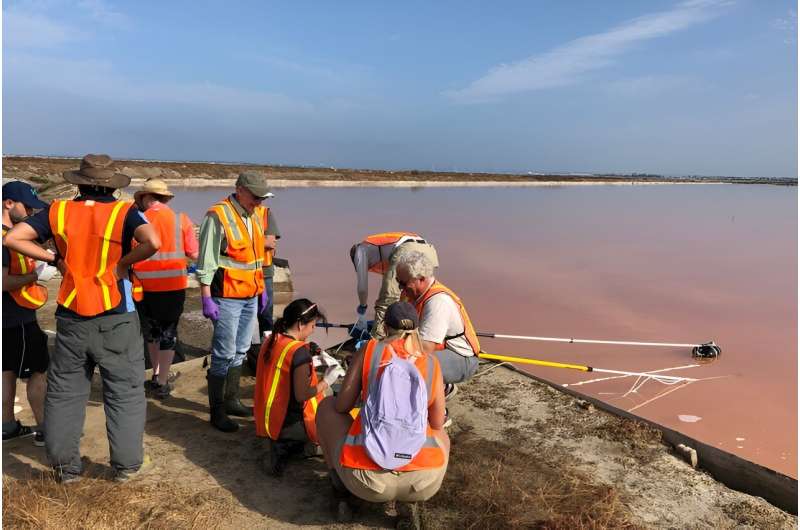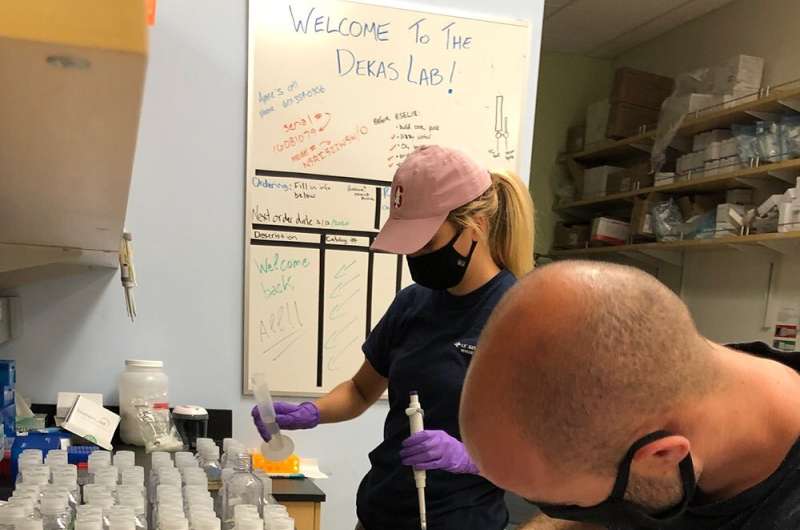This article has been reviewed according to Science X's editorial process and policies. Editors have highlighted the following attributes while ensuring the content's credibility:
fact-checked
peer-reviewed publication
trusted source
proofread
New research on microbes expands the known limits for life on Earth and beyond

New research led by Stanford University scientists predicts life can persist in extremely salty environments, beyond the limit previously thought possible.
The study, published Dec. 22 in Science Advances, is based on analysis of metabolic activity in thousands of individual cells found in brines from industrial ponds on the coast of Southern California, where water is evaporated from seawater to harvest salt. The results expand our understanding of the potential habitable space throughout our solar system, and of the possible consequences of some earthly aquatic habitats becoming saltier as a result of drought and water diversion.
"We can't look everywhere, so we have to be really deliberate about where and how we try to find life on other planets," said senior study author Anne Dekas, an assistant professor of Earth system science in the Stanford Doerr School of Sustainability. "Having as much information as we can about where and how life survives in extreme environments on Earth allows us to prioritize targets for life-detection missions elsewhere, and increases our chances of success."
Scientists interested in detecting life beyond Earth have long studied salty environments knowing that liquid water is necessary for life, and salt allows water to remain liquid at a wider range of temperatures. Salt can also preserve signs of life, like pickles in brine. "We think that salty places are good candidates for finding signs of past or present life," said lead study author Emily Paris, a Ph.D. student in Earth system science who is part of the Dekas Lab. "Salt could be the very thing that makes another planet habitable, even though it's also an inhibitor to life in high concentrations on Earth."
The new research is part of a large collaboration called Oceans Across Space and Time led by Cornell University professor Britney Schmidt and funded by NASA's Astrobiology Program, which brings together microbiologists, geochemists, and planetary scientists. Their goal: to understand how ocean worlds and life co-evolve to produce detectable signs of life, past or present. Understanding the conditions that make an ocean world habitable, and developing better ways to detect signals of biological activity, are steps toward predicting where life could be found elsewhere in the solar system.
Paris says we should also consider how changing salinities impact ecosystems here on Earth. For example, receding water levels in Utah's Great Salt Lake have caused an increase in salinity that could affect life all the way up the food chain.
"Beyond a life-detection perspective, understanding the impact of salinity is important for conservation and sustainability on Earth," Paris said. "Our research shows how increasing salinity changes microbial community composition and rates of microbial metabolism. These factors can impact nutrient cycling, as well as the lives of crustaceans and insects, which are essential food sources for migratory birds and other aquatic animals.

Saltiest waters on Earth
Travelers flying over salt ponds like those at the South Bay Salt Works—where samples for this study were collected—or along the San Francisco Bay can spot a kaleidoscope of some of Earth's heartiest microbes glowing neon green, rusty red, pink, and orange. The patchwork of colors reflects the array of aquatic microbes adapted to survive at different levels of salinity, or what scientists call "water activity"—the amount of water available for biological reactions that allow microbes to grow.
"We're curious to find out at what point water activity becomes too low, salinity becomes too high, and where microbial life can no longer survive," said Paris. Seawater has a water activity level of about 0.98, compared to 1 for pure water. Most microbes stop dividing below water activity of 0.9, and the absolute lowest water activity level reported to sustain cell division in a laboratory setting is just over 0.63.
In the new study, the researchers predicted a new limit of life. They estimate life could be active at levels as low as 0.54.
The Stanford scientists teamed up with colleagues from around the country to collect samples from the South Bay Salt Works, home to some of the saltiest waters on Earth. They filled hundreds of bottles with brine from ponds of varying salinity levels at the salt works, then drove them back to Stanford for analysis.
Finding life faster
Previous studies looking for the water-activity limit of life have used pure cultures to look for the point at which cell division stops, marking the endpoint of life. But in these extreme conditions, life doubles painfully slowly. If researchers rely on cell division as their test of when life ceases, they face years-long lab experiments that aren't practical for graduate students like Paris. Even when conducted, studies on cell division don't indicate when life dies; indeed, cells may be metabolically active and still very much alive, even when not replicating.

So Paris and Dekas looked at microbes from open-air salt ponds to identify a different limit of life—the limit of cellular activity.
The research team made three key improvements to previous research. First, instead of using pure cultures, which are a scientist's standard best guess at which particular species or strain of microbe is going to be the most resilient, they went to an actual ecosystem. At the salt works, the environment naturally selected for a complex community of organisms best adapted to those particular conditions.
Second, the researchers used a more flexible definition of life. They considered not only cell division, but also cell building as a sign of life. "It's a little like observing a human eating a meal, or growing. It's a sign of active life, and a necessary precursor of replication, but much faster to observe," Dekas said.
In hundreds of brine samples—some of them so salty they were thick as syrup—they identified the water activity level and how much if any carbon and nitrogen was being incorporated into cells found in the brines. With this approach, they were able to detect when a cell increased its biomass by as little as half of 1%. By contrast, conventional methods focused on cell division can only detect biological activity after cells have roughly doubled their biomass. Then, based on how this process slowed as water activity decreased, the scientists predicted the cutoff for it would stop altogether.
Third, while other scientists have measured carbon and nitrogen incorporation in brines at a bulk level, the Stanford team conducted a cell-by-cell analysis with a rare instrument at Stanford called a nanoSIMS—one of only a handful in the country. This sensitive technique allowed them to observe activity in individual cells in the midst of other "pickled" cells whose presence would obscure the signal of activity in a bulk analysis, and achieve their low detection limit.
"Single-cell activity analysis of environmental samples is still pretty rare," said Dekas. "It was key to our analysis here, and as it is more widely applied I think we will see advances in microbial ecology that are broadly relevant, from understanding global climate to human health. We are still only beginning to understand the microbial world at the single-cell level."
More information: Emily R. Paris et al, Single-cell analysis in hypersaline brines predicts a water-activity limit of microbial anabolic activity, Science Advances (2023). DOI: 10.1126/sciadv.adj3594
Journal information: Science Advances
Provided by Stanford University





















